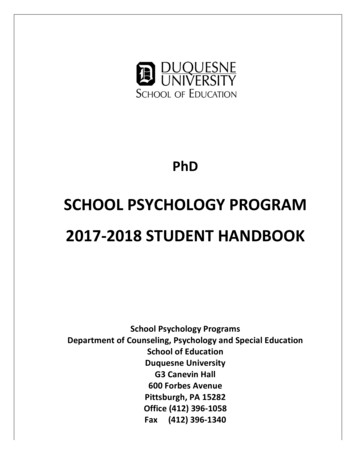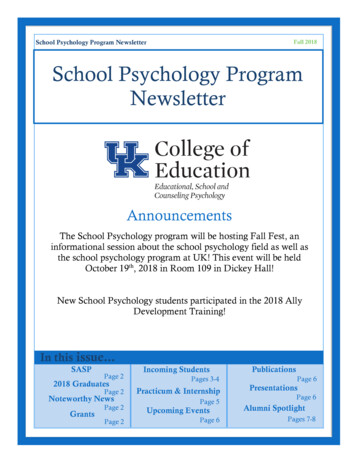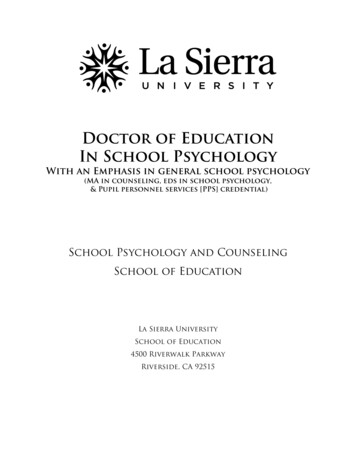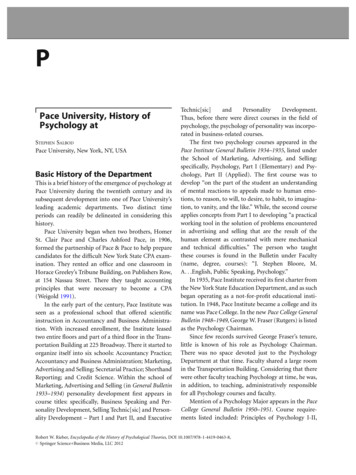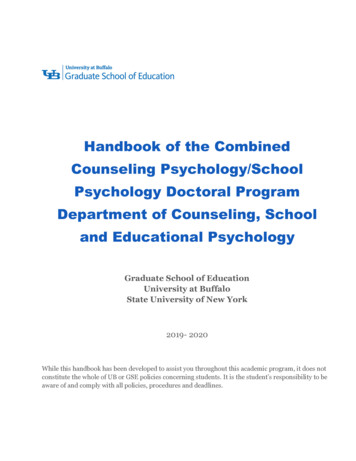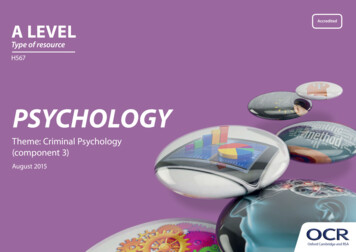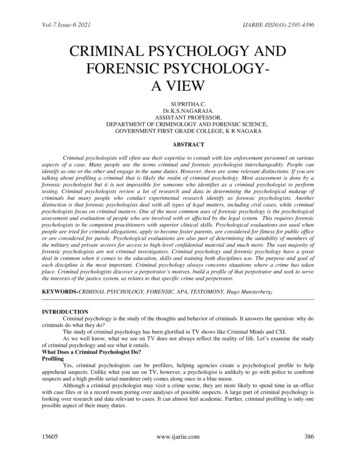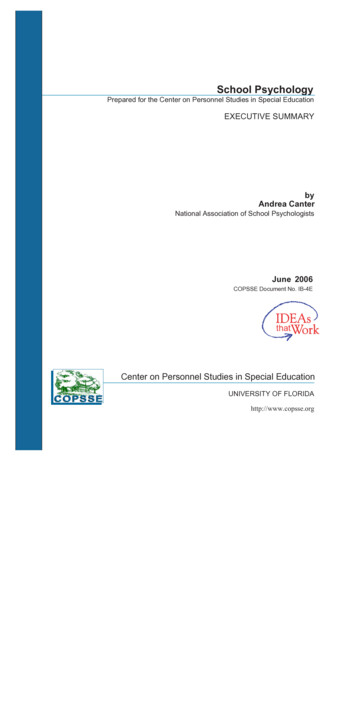
Transcription
School PsychologyPrepared for the Center on Personnel Studies in Special EducationEXECUTIVE SUMMARYbyAndrea CanterNational Association of School PsychologistsJune 2006COPSSE Document No. IB-4ECenter on Personnel Studies in Special EducationUNIVERSITY OF FLORIDAhttp://www.copsse.org
Center on Personnel Studies in Special EducationUniversity of FloridaJohns Hopkins UniversityVanderbilt UniversityUniversity of Colorado - BoulderInstructional Research Group, Long Beach, CACOPSSE research is focused on the preparation of special education professionals and itsimpact on beginning teacher quality and student outcomes. Our research is intended to informscholars and policymakers about advantages and disadvantages of preparation alternatives andthe effective use of public funds in addressing personnel shortages.In addition to our authors and reviewers, many individuals and organizations have contributedsubstantially to our efforts, including Drs. Erling Boe of the University of Pennsylvania andElaine Carlson of WESTAT. We also have benefited greatly from collaboration with the NationalClearinghouse for the Professions in Special Education, the Policymakers Partnership, and theirparent organizations, the Council for Exceptional Children and the National Association of StateDirectors of Special Education.The Center on Personnel Studies in Special Education, H325Q000002, is a cooperativeagreement between the University of Florida and the Office of Special Education Programs ofthe U. S. Department of Education. The contents of this document do not necessarily reflect theviews or policies of the Department of Education, nor does mention of other organizations implyendorsement by them.Recommended citation:Canter, A. (2006). School psychology. (COPSSE Document Number IB-4E). Gainesville, FL:University of Florida, Center on Personnel Studies in Special Education.GAdditional Copies may be obtained from:COPSSE ProjectP.O. Box 117050University of FloridaGainesville, FL 32611352-392-0701352-392-2655 (Fax)U. S. Office of SpecialEducation ProgramsThere are no copyright restrictions on this document; however,please credit the source and support of the federal funds whencopying all or part of this document.
INTRODUCTIONThis paper briefly presents the history of school psychology in the context of professional roles,training, and credentialing and considers key issues facing the profession today: balancing professional roles as gatekeepers versus comprehensive service providers inorder to integrate services that address both mental health and academic concernseffectively serving a diverse student population with a relatively homogeneous work force serving a broader segment of the school community with a current and predicted shortageof qualified personnel.School psychology is looking to the future and seeking strategies that will allow the profession toaddress student needs effectively and efficiently, while ensuring the longevity of a highly qualifiedwork force.PERSONNEL DILEMMAS IN HISTORICAL PERSPECTIVEEarly HistoryEarly school psychologists were diagnosticians who studied the attributes of children to predictschool success and determine the need for remedial or specialized instruction. Students typicallyreferred were failing academically or exhibited severe emotional disturbance.Evolving RolesA medical model of diagnosis and classification was well entrenched when federal specialeducation regulations were first adopted in the mid-1970s. Eventually every school districtemployed at least one school psychologist. A slow revolution in school psychology toward roleexpansion beyond diagnostic assessment began with two major conferences in the early 1980s(Spring Hill and Olympia) and continued with the publication of the first Blueprint for theprofession. Consultation to address individual academic and behavioral difficulties, as well asgroup and systems intervention (e.g., at the school or district level), were promoted as ways toexpand roles and to help prevent more serious student difficulties. Few school districtsimplemented the recommended paradigm shifts because budgets delayed broad roles for schoolpsychologists. Ratios of students to school psychologists did steadily improve, and referral tospecial education increased rapidly. With better ratios, many school psychologists includedconsultation, counseling, staff training, and group interventions in their repertoire of professionalservices in addition to the traditional diagnostic role.Slow ChangeAt the end of the 1980s, the first national credential for school psychologists was introduced.Affiliated with the National Association of School Psychologists [NASP], the Nationally CertifiedSchool Psychologist credential [NCSP] solidified several trends in the profession: broadrecognition of the specialist level of training, uniform training standards incorporating evolvingprinciples, and a commitment to ongoing professional development.Paradigm Shift: New Tools, New Standards, New DilemmasCalls for educational accountability led to evidence-based practice and a focus on outcomes. Moreprecise and frequent measurement of student skills and behavior enabled curriculum-basedassessment, curriculum-based measurement, functional behavior assessment, and response tointervention techniques. Within collaborative team decision-making, problem-solving models ofservice delivery evolved, emphasizing early identification and support of at-risk students separatefrom any special education involvement. For school psychologists, this model has promotedbroader roles in consultation and intervention design. A Blueprint II supported ecological overmedical models, problem-solving strategies over refer-test-place paradigms, and curriculum-based1
assessment over traditional norm-referenced approaches. The efficacy of the special educationmodel—responsible for the rapid growth of school psychology—was questioned. New standardsfor training and practice included: data-based decision making and accountabilityinterpersonal communication, collaboration, and consultationeffective instruction and development of cognitive-academic skillssocialization and development of life competenciesstudent diversity in development and learningschool structure, organization, and climateprevention, wellness promotion, and crisis interventionhome-school-community collaborationresearch and program evaluationlegal, ethical practice, and professional development.Projected shortages of personnel, trainers, and training programs; economic downturns; andaccountability initiatives spurred calls for reform to service an increasingly diverse and at-riskstudent population.Challenges to Role ChangeTo fulfill the agenda established at the 2002 Conference on the Future of School Psychology,school psychologists will have to move beyond the emphasis on individual diagnosis andtreatment and more substantially to prevention, early intervention, instructional design, mentalhealth services, and family support. Even with the difficulties and fear associated with rolechange, many trainers, practitioners, and professional leaders are optimistic that schoolpsychology is heading in a proactive direction.KEY DILEMMAS FACING SCHOOL PSYCHOLOGYFrom Gatekeeper to Comprehensive Service ProviderThere is ample evidence that under more comprehensive service delivery models both studentsand school psychologists thrive. School psychologists must provide a broader array of services toa broader student population in order to have the necessary impact on student achievement andadjustment. These include: School-based mental health services. School psychologists are being encouraged toestablish school-based mental health services prevention, early intervention, and tertiaryservices, including crisis prevention, intervention, and postvention services. Improving instruction. School psychologists, who have expertise in measurement, learning,cognition, and evaluation of research findings, are in ideal positions to translate research oninstruction to effective, empirically based classroom practices and implement problemsolving models. Positive behavior support. School psychologists are providing leadership in fosteringimproved academic outcomes through positive behavior support involving data-baseddecision making using functional behavioral assessment and ongoing monitoring of theoutcomes of intervention. Integrating instructional and mental health supports. Mental health and academicperformance are clearly intertwined, and school psychologists must be prepared to addressand integrate both areas in their daily practice.DiversityIn demographics, the profession and students served are very dissimilar (e.g., about 93% ofpracticing school psychologists are identified as Caucasian). Because these demographics will not2
change dramatically soon, it is important that training and professional development emphasizeculturally competent practices.Personnel ShortagesServing the student population with a dwindling work force will require a multi-faceted approach:recruiting and retaining professionals, identifying different approaches to service delivery thatincrease both effectiveness and efficiency, and shifting to more indirect strategies that addresssystemic issues.PROFESSIONAL TRAINING OF SCHOOL PSYCHOLOGISTSAccreditation and program approval refer to the systematic review of a university’s schoolpsychology training program relative to the criteria adopted by a professional body such as theNational Association of School Psychologists [NASP], through its affiliations with the NationalCouncil for Accreditation of Teacher Education [NCATE] and the American PsychologicalAssociation [APA]. Credentialing refers to the state or national process of evaluating the trainingof an individual school psychologist relative to the training and practice standards of that state ornational board and the granting of a certificate or license to practice.Scope of TrainingToday school psychologists need a greater array of skills than did their predecessors of the 1970sand 1980s. School psychologists for the foreseeable future must have substantial expertise in: understanding special education laws and regulations eligibility determination translating research to practice in the areas of instruction, particularly early literacy,reading, study skills, and meta-cognition positive behavior supports mental health (prevention and intervention) crisis management school organization collaborative consultation and program evaluation service delivery in a manner that is culturally sensitive and supportive of a vast diversity oflearners and their families working with a wide range of disabilities.Availability of Training and TrainersApproximately 218 institutions of higher education offer some type of school psychologyprogram, an estimated 294 different degree programs across the country. Estimates of schoolpsychology graduates across all levels of training have typically ranged from 1,750 to 1,950 peryear, with little change in completion rates over the past 15 years. Unfilled faculty positions haveincreased, and the future work force may depend more on successful recruitment of trainers thantrainees.Entry-Level TrainingAPA considers that doctoral-level preparation is required for independent practice as aprofessional psychologist, which includes school psychology. NASP maintains that the entry levelfor professional practice is the completion of a specialist-level graduate degree (60 semesterhours). The shift of school psychology from a master’s- to specialist-level profession over the past30 years is in part attributed to the adoption of higher standards for both credentialing and trainingby NASP, beginning in the 1970s. The establishment of the NCSP credential in 1989 as well asrigorous training standards are further guarantees that future school psychologists will hold at leastthe specialist credential or its equivalent. Respecialization the training of individuals who3
already hold degrees or credentials in closely related fields (e.g., child clinical psychology) is apossibility.National StandardsNational standards for the preparation of school psychologists have been established by NASP.All school psychology training programs are eligible for NASP approval. APA also accreditsschool psychology doctoral programs as an area of specialty preparation within professionalpsychology.In 2004, 62% of specialist programs and 68% of doctoral programs had attained conditional or fullapproval through NASP. An estimated 75% of school psychology doctoral programs areaccredited by the APA. More than half of the states (26) now include the NCSP as a criterion forstate certification or licensure.Training Diverse ProfessionalsMore systematic attention to both recruitment and retention is needed if the profession is tobecome a better reflection of the face of the public schools today. Aside from increasing thediversity of those entering school psychology training, pre-service training and professionaldevelopment opportunities give more attention to topics that will better prepare all future andcurrent school psychologists to address the needs of diverse student populations.Training Issues for the FutureDiscussions of the future of school psychology preparation must address the scope of programcontent and broader professional roles (particularly regarding instruction and mental health); thecontinuing prevalence of specialist-level training; the stability of the number of institutions andgraduate programs engaged in training; the lack of diversity among individuals seeking andcompleting training; and the apparently insufficient number of graduates entering the work force.Given this context, the profession must focus its training efforts to do the following: reconceptualize the curriculum to better reflect the demands and needs of today’s schoolsand students increase the number of school psychology graduate programs that meet NASP and APArequirements increase accessibility to valid alternative training options in several special areas of specificpersonnel shortages (e.g., rural areas, states with few or no traditional graduate trainingprograms, historically black colleges and universities). identify successful strategies to recruit school psychologists to serve as trainers in graduateinstitutions develop alternatives to traditional faculty appointments, including adjunct arrangements continue to implement NASP standards that emphasize competency-based practice anddevelopment of performance-based program assessment and accountability systems identify successful strategies to increase the number of trainees, including part-timeresidency requirements, distance learning options, and respecialization programs develop effective recruitment strategies to increase the enrollment of students fromunderrepresented groups.CERTIFICATION AND LICENSURE ISSUESAll states have established some form of certification or licensure for school psychology practicein school settings. Although most states issue a credential at one title and degree level, some stateshave multiple credential levels generally distinguished by graduate hours and degree (master’s,specialist, doctoral). In addition to state certification and licensure, many school psychologists alsohold the NCSP from NASP.4
Models and StandardsNASP standards specify the following requirements: a minimum of 60 semester hours of graduatecourse work; demonstrated competencies in specified domains of professional practice as reflectedby course work in psychology, education, and school psychology as well as associated practicumexperiences; and the completion of a full academic year internship (1200 clock hours). NASPrecommends that states allow use of the NCSP as one option—but not the only option—forobtaining a state school psychology credential. Even states that do not allow the NCSP as analternative route to credentialing often have standards for state certification that are similar oridentical to the NCSP requirements.Respecialization and CredentialingOther professionals who are interested in school-based practice but have been prepared in otherareas of psychology (clinical and counseling psychologists) or mental health disciplines (mentalhealth counselors) are a resource. Personnel shortages in schools, paired with employmentchanges in other settings, have created a new group of professionals interested in the opportunitiesand stability of school positions.There has been consensus among trainers and leaders in school psychology that individualsconsidering respecialization seek guidance from school psychology training programs to ensureadequate preparation. Although APA and NASP have different approaches to respecialization, theorganizations agree that respecialization should include formal preparation and supervised fieldexperiences through APA- or NASP-approved training programs.Future Credentialing ConsiderationsCritical recommendations regarding certification and licensure for the future include: Increase the number of states adopting national credentialing standards and accept theNCSP as a means of obtaining state school psychology certification or licensure, whichwill facilitate reciprocity across states. Increase the number and diversity of school psychologists seeking national certification,including targeting newly trained and state-credentialed professionals. Improve coordination of requirements for school psychology professional development andcontinuing education to facilitate renewal of state and national credentials for school-basedpractice. Develop and implement competency-based systems for respecialization of allied mentalhealth professionals. Assure the provision of comprehensive school psychological services by the most highlyqualified personnel by mandating training in Blueprint competency domains as criteria forinitial credentialing, in contrast to the still-current emphasis on narrow gatekeeping skills.SUPPLY AND DEMANDDetermining the precise number of school psychologists practicing today is difficult, but estimatesrange from 25,000 to 30,000. An estimated 1,750 new school psychologists enter the field eachyear. There is a graying effect, and the median age of school psychologists has increasedsignificantly since the mid-1980s. Lack of minority representation among school psychologists isa concern. As bright spots, attrition does not appear to be a significant factor contributing topersonnel shortages, and there has been a steady trend toward improved service ratios of schoolpsychologists to students within a school with a national mean ratio of 1:1700 or 1:1800.The Demand for School PsychologistsSeveral population trends and national initiatives could create more demand for schoolpsychologists.5
changing demographics of school enrollmentsNo Child Left Behind.IDEA 2004Surgeon General’s Report on Child Mental Health.Personnel Shortages: ImplicationsThoughtful interpretation of the most recent data supports the conclusions that there is currently ashortage of school psychologists and that a more profound shortage is likely to occur in the nearfuture. This has important implications for the field and the quality of psychological servicesavailable in the schools. Loss of positionsLoss of training opportunitiesLoss of quality comprehensive servicesContinued shortage of diverse professionalsCredentialing alternatives.Future Supply and Demand ConsiderationsAs long as the balance of supply and demand is skewed in the direction of personnel shortages, theschool psychology profession will face significant challenges in achieving its goals forcomprehensive, culturally competent service delivery. Strategies to preserve the dwindling workforce concern recruitment, retention, retraining, and a general reconceptualization of servicedelivery.CONCLUSIONSTo implement an agenda for the profession that encompasses new models of comprehensiveservices, school psychology must ensure a sufficient and sustainable pool of diverse, trained, andcredentialed practitioners.6
school psychology doctoral programs as an area of specialty preparation within professional psychology. In 2004, 62% of specialist programs and 68% of doctoral programs had attained conditional or full approval through NASP. An estimated 75% of school psychology doctoral programs are accredited by the APA.


